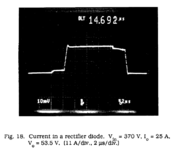Magnethicc
Member level 2
Can someone explain why does the primary current of a PSFB has the following waveform:

at first current ramps up (magnetizing + reflected output inductor current).
At the start of the phase in which current is circulating there is a dip in the current waveform.
My question is why there is a dip? where did it came from and where did it go?
The article states that the reason for this dip is due to several capacitances around the transformer (for example snubbers and rectifier junction capacitances) that steal current to charge/discharge - if this is the case why wont the current will ramp back up once the charging/discharging is done?
at first current ramps up (magnetizing + reflected output inductor current).
At the start of the phase in which current is circulating there is a dip in the current waveform.
My question is why there is a dip? where did it came from and where did it go?
The article states that the reason for this dip is due to several capacitances around the transformer (for example snubbers and rectifier junction capacitances) that steal current to charge/discharge - if this is the case why wont the current will ramp back up once the charging/discharging is done?
Attachments
Last edited:
